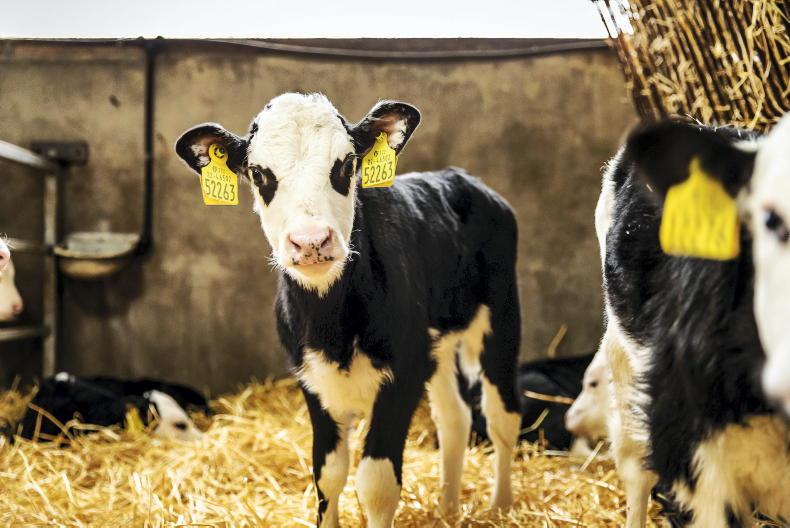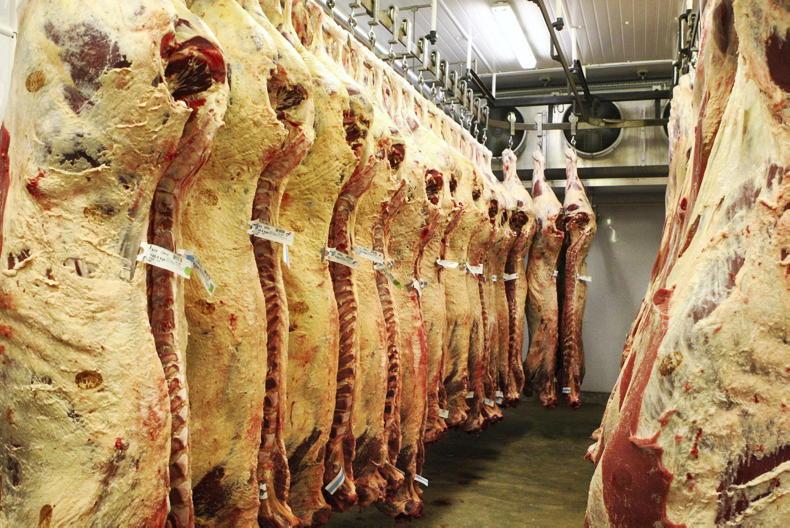140: the number of cattle slaughtered off the farm this year. Drafting started on 19 August and finished the week before Christmas.267kg: average carcase weight of the heifers. This is back slightly on 2020, but the average slaughter age is over three weeks younger this year.311kg: average carcase weight of the bullocks. As with the heifers, slaughter age has reduced this year compared to last year which resulted in a 7kg lower average carcase weight in 2021.19.8: average age in months of both bullocks and heifers at slaughter. The heifers averaged 19.4 while the bullocks were just over 20.1 months old on average.90: number of cattle drafted for slaughter off grass. This meant 50 had to be housed for a short indoor finishing period. A breakdown of this figure sees over 86% of the heifers and 46% of the bullocks drafted from pasture.
Calves started to arrive on farm from 22 February. \ Philip Doyle
€212: calf purchase price. For heifers, the average was €191 ranging from €183 for Hereford heifers to €315 for Belgian Blue heifers. The bullocks came in at an average price of €227, again ranging from €217 for Angus bulls up to €325 for a small number of Belgian Blue bulls.€1,371: bullock carcase value – the average bullock carcase value is up over €170 on 2020 despite being 7kg lighter in 2021, such is the difference in beef price. €1,172: heifer carcase value – the average price per kilo paid for the heifers is actually lower than for the bullocks as they were killed earlier in autumn at a lower base price.245 days at grass: after a false start in early March where cattle had to be rehoused for a week of bad weather, once stock got to grass by the middle of the month, there was nothing housed until 18 November.0.96kg/day: average daily gain of the 2021-born stock from turnout to grass up until housing for winter. 271kg: average weight of the 2021-born heifers at housing. With the decent weather and grass growth this back end, housing was over three weeks later than usual on the farm. Both bullocks and heifers were getting 1.5kg/day concentrate at grass over the last two months pre-housing.288kg: average weight of the 2021-born bullocks at housing. They are currently just ahead of target for where they need to be on the 19-month system blueprint. The target average daily gain for the first winter period is 0.75kg/day.48 days: the average period of meal feeding prior to slaughter. This ranged from 0 for two heifers that were slaughtered with no meal feeding up to 82 for three Belgian Blue heifers that were the last to be drafted for slaughter. 1.15kg/day: average daily gain of cattle over the finishing period. The finishing diet for most was grass plus either 3kg or 4kg/day meal. Daily gains from those that were fed and drafted earlier in the year were closer to 1.3kg/day, while those that were drafted last from grass in October were doing just over 1kg/day by that time.192kg: average amount of meal fed over the finishing period. To avoid having over fat animals at low carcase weights, meal feeding was only introduced to heifers over 470kg and bullocks over 500kg. Heifers were built up to 3kg/day while bullocks went up to 4kg/day.
52.8%: killout percentage of the heifers. This ranged depending on breed and finishing diet. Those finished off grass were mostly early maturing Angus and Herefords. They averaged 51.5% while the Belgian Blue heifers slaughtered out of the shed had an average killout percentage of 54.7%.53.6%: killout percentage of the bullocks. Again, this ranged from an average of just over 52% for bullocks off grass up to 54% for those out of the shed. 
The bullocks slaughtered off the farm had an average carcase weight of 311kg this year while the heifers averaged 276kg.
3+ heifer carcase fat score: while the average sat at 3+ there was a decent range within this. From the first draft of cattle in August a number of cattle were 4+ and even one heifer graded a 5-. However, the majority graded between a 3= and 3+.3- bullock carcase fat score: as expected, a lower carcase fat score with the bullocks. There were less extremes with the bullocks. Although there were two animals that graded 2-, the rest were between 2= and 3= for the majority.
140: the number of cattle slaughtered off the farm this year. Drafting started on 19 August and finished the week before Christmas.267kg: average carcase weight of the heifers. This is back slightly on 2020, but the average slaughter age is over three weeks younger this year.311kg: average carcase weight of the bullocks. As with the heifers, slaughter age has reduced this year compared to last year which resulted in a 7kg lower average carcase weight in 2021.19.8: average age in months of both bullocks and heifers at slaughter. The heifers averaged 19.4 while the bullocks were just over 20.1 months old on average.90: number of cattle drafted for slaughter off grass. This meant 50 had to be housed for a short indoor finishing period. A breakdown of this figure sees over 86% of the heifers and 46% of the bullocks drafted from pasture.
Calves started to arrive on farm from 22 February. \ Philip Doyle
€212: calf purchase price. For heifers, the average was €191 ranging from €183 for Hereford heifers to €315 for Belgian Blue heifers. The bullocks came in at an average price of €227, again ranging from €217 for Angus bulls up to €325 for a small number of Belgian Blue bulls.€1,371: bullock carcase value – the average bullock carcase value is up over €170 on 2020 despite being 7kg lighter in 2021, such is the difference in beef price. €1,172: heifer carcase value – the average price per kilo paid for the heifers is actually lower than for the bullocks as they were killed earlier in autumn at a lower base price.245 days at grass: after a false start in early March where cattle had to be rehoused for a week of bad weather, once stock got to grass by the middle of the month, there was nothing housed until 18 November.0.96kg/day: average daily gain of the 2021-born stock from turnout to grass up until housing for winter. 271kg: average weight of the 2021-born heifers at housing. With the decent weather and grass growth this back end, housing was over three weeks later than usual on the farm. Both bullocks and heifers were getting 1.5kg/day concentrate at grass over the last two months pre-housing.288kg: average weight of the 2021-born bullocks at housing. They are currently just ahead of target for where they need to be on the 19-month system blueprint. The target average daily gain for the first winter period is 0.75kg/day.48 days: the average period of meal feeding prior to slaughter. This ranged from 0 for two heifers that were slaughtered with no meal feeding up to 82 for three Belgian Blue heifers that were the last to be drafted for slaughter. 1.15kg/day: average daily gain of cattle over the finishing period. The finishing diet for most was grass plus either 3kg or 4kg/day meal. Daily gains from those that were fed and drafted earlier in the year were closer to 1.3kg/day, while those that were drafted last from grass in October were doing just over 1kg/day by that time.192kg: average amount of meal fed over the finishing period. To avoid having over fat animals at low carcase weights, meal feeding was only introduced to heifers over 470kg and bullocks over 500kg. Heifers were built up to 3kg/day while bullocks went up to 4kg/day.
52.8%: killout percentage of the heifers. This ranged depending on breed and finishing diet. Those finished off grass were mostly early maturing Angus and Herefords. They averaged 51.5% while the Belgian Blue heifers slaughtered out of the shed had an average killout percentage of 54.7%.53.6%: killout percentage of the bullocks. Again, this ranged from an average of just over 52% for bullocks off grass up to 54% for those out of the shed. 
The bullocks slaughtered off the farm had an average carcase weight of 311kg this year while the heifers averaged 276kg.
3+ heifer carcase fat score: while the average sat at 3+ there was a decent range within this. From the first draft of cattle in August a number of cattle were 4+ and even one heifer graded a 5-. However, the majority graded between a 3= and 3+.3- bullock carcase fat score: as expected, a lower carcase fat score with the bullocks. There were less extremes with the bullocks. Although there were two animals that graded 2-, the rest were between 2= and 3= for the majority.








 This is a subscriber-only article
This is a subscriber-only article













SHARING OPTIONS: